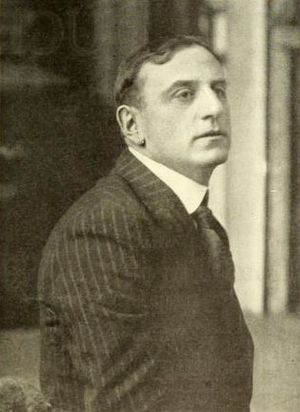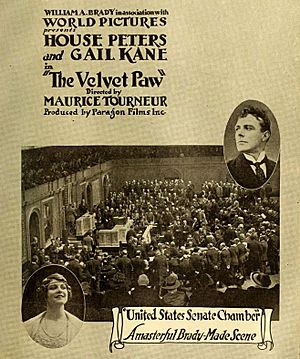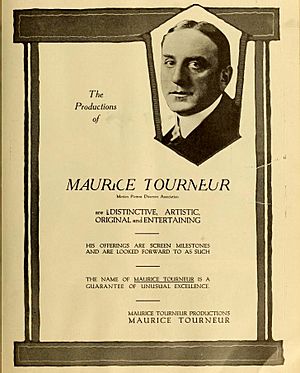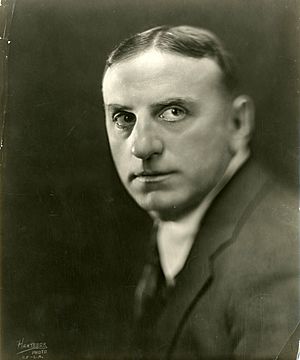Maurice Tourneur facts for kids
Quick facts for kids
Maurice Tourneur
|
|
|---|---|

Tourneur in 1916
|
|
| Born |
Maurice Félix Thomas
2 February 1876 Épinettes, Paris, France
|
| Died | 4 August 1961 (aged 85) Paris, France
|
| Resting place | Père Lachaise Cemetery |
| Spouse(s) |
Fernande Petit
(m. 1904, divorced)Louise Lagrange |
| Children | Jacques Tourneur |
Maurice Félix Thomas, known as Maurice Tourneur, was a famous French film director and screenwriter. He was born on February 2, 1876, and passed away on August 4, 1961. He is remembered for his creative silent films and for helping shape early American cinema.
Contents
Early Life and Career Beginnings
Maurice Félix Thomas was born in Paris, France. His father was a businessman. When he was young, Maurice first trained as an artist, drawing for magazines. But soon, he became very interested in the theater.
In 1904, he married an actress named Fernande Petit. They had a son, Jacques Tourneur, who also became a well-known film director in America.
Maurice started his career in entertainment as an actor, using the stage name Maurice Tourneur. He performed in small roles and even toured England and South America with a famous actress named Gabrielle Réjane.
Becoming a Film Director
In 1911, Maurice Tourneur became interested in the new world of filmmaking. He started working as an assistant director for the Éclair film company. He learned very quickly and soon began directing his own films. He worked with big French stars of that time.
In 1914, French film companies started to grow in the United States. So, Tourneur moved to New York City to direct silent films for Éclair's American studio. He then moved to another company, World Film Corporation. There, he directed important early American movies like The Wishing Ring and Alias Jimmy Valentine.
Maurice Tourneur quickly became a respected director in American cinema. He was also a founding member of the Motion Picture Directors Association on the East Coast. He and his team were very skilled. They used new technology and unique visual styles in their films. This made his movies look very special and critics loved them.
Tourneur admired another famous director, D.W. Griffith. He also thought American actors were more skilled than those in Europe at the time. He called Mary Pickford the best screen actress in the world. However, he didn't like the idea of the "star system," where actors became very famous and were advertised a lot.
Later Career and Return to France
After directing several creative films for Artcraft Pictures Corporation, Tourneur started his own film company in 1918. In 1921, he became a citizen of the United States. By 1922, he believed that the future of movies was in Hollywood. He was hired by Samuel Goldwyn to make a film called The Christian.
However, Tourneur's career in the U.S. faced challenges in the 1920s. His focus on beautiful visuals sometimes made his stories harder to follow. He also separated from his wife Fernande in 1923. In 1928, he was removed from directing a film called The Mysterious Island. This marked the end of his career in America.
After this, Tourneur decided to move back to France. He continued to make films there and in Germany. He easily adapted to making talkies, which were movies with sound. In 1933, he met his second wife, actress Louise Lagrange, while working on a film.
Tourneur directed about two dozen more films, including several crime thrillers. In 1949, he was seriously injured in a car accident and lost a leg. Because of his health and age, he could no longer direct films. But he loved to read and was a skilled artist. He kept busy by painting and translating detective novels from English into French.
Legacy and Recognition
Maurice Tourneur passed away in 1961 and was buried in the Père Lachaise Cemetery in Paris.
He was honored with a star on the Hollywood Walk of Fame in California.
Some of his films are considered very important. His 1917 film The Poor Little Rich Girl, his 1918 film The Blue Bird, and his 1920 film The Last of the Mohicans have been chosen by the United States Library of Congress for preservation in the National Film Registry. This means they are saved because they are culturally significant. Also, his 1915 film The Cub is being restored by film preservation groups.
Partial Filmography
- Jean la Poudre (1912)
- The System of Doctor Goudron (1912)
- Figures de cire (1914)
- Mother (1914)
- The Man of the Hour (1914)
- The Wishing Ring (1914)
- Alias Jimmy Valentine (1915)
- The Cub (1915)
- The Ivory Snuff Box (1915)
- The Butterfly on the Wheel (1915)
- The Pawn of Fate (1915)
- The Hand of Peril (1916)
- The Closed Road (1916)
- The Velvet Paw (1916)
- The Rail Rider (1916)
- A Girl's Folly (1916)
- The Whip (1917)
- The Undying Flame (1917)
- Exile (1917)
- The Law of the Land (1917)
- The Pride of the Clan (1917)
- The Poor Little Rich Girl (1917)
- Barbary Sheep (1917)
- The Rise of Jennie Cushing (1917)
- Rose of the World (1917)
- The Blue Bird (1918)
- Prunella (1918)
- A Doll's House (1918)
- The Sporting Life (1918)
- Woman (1918)
- My Lady's Garter (1919)
- The White Heather (1919)
- The Life Line (1919)
- Victory (1919)
- The Broken Butterfly (1919)
- The County Fair (1920)
- The Great Redeemer (1920)
- While Paris Sleeps (1923)
- Treasure Island (1920)
- The White Circle (1920)
- Deep Waters (1920)
- The Last of the Mohicans (1920)
- The Bait (1921)
- Foolish Matrons (1921)
- Lorna Doone (1922)
- The Brass Bottle (1923)
- Les Deux Gosses (1923)
- The Christian (1923)
- The Isle of Lost Ships (1923)
- Torment (1924)
- The White Moth (1924)
- The Sporting Life (1925)
- Never the Twain Shall Meet (1925)
- Aloma of the South Seas (1926)
- Old Loves and New (1926)
- The Crew (1928)
- The Ship of Lost Souls (1929)
- Accusée, levez-vous! (Accused, Stand Up!) (1930)
- Departure (1931)
- Dance Hall (1931)
- In the Name of the Law (1932)
- Les Gaietés de l'escadron (1932)
- The Two Orphans (1933)
- Le Voleur (1933)
- Justin de Marseille (1934)
- Koenigsmark (1935)
- Samson (1936)
- The Patriot (1938)
- Katia (1938)
- Volpone (1941)
- La Main du diable (The Hand of the Devil, aka Carnival of Sinners) (1943)
- Cécile est morte (1944)
- After Love (1948)
- Dilemma of Two Angels (1948)
See also
 In Spanish: Maurice Tourneur para niños
In Spanish: Maurice Tourneur para niños




